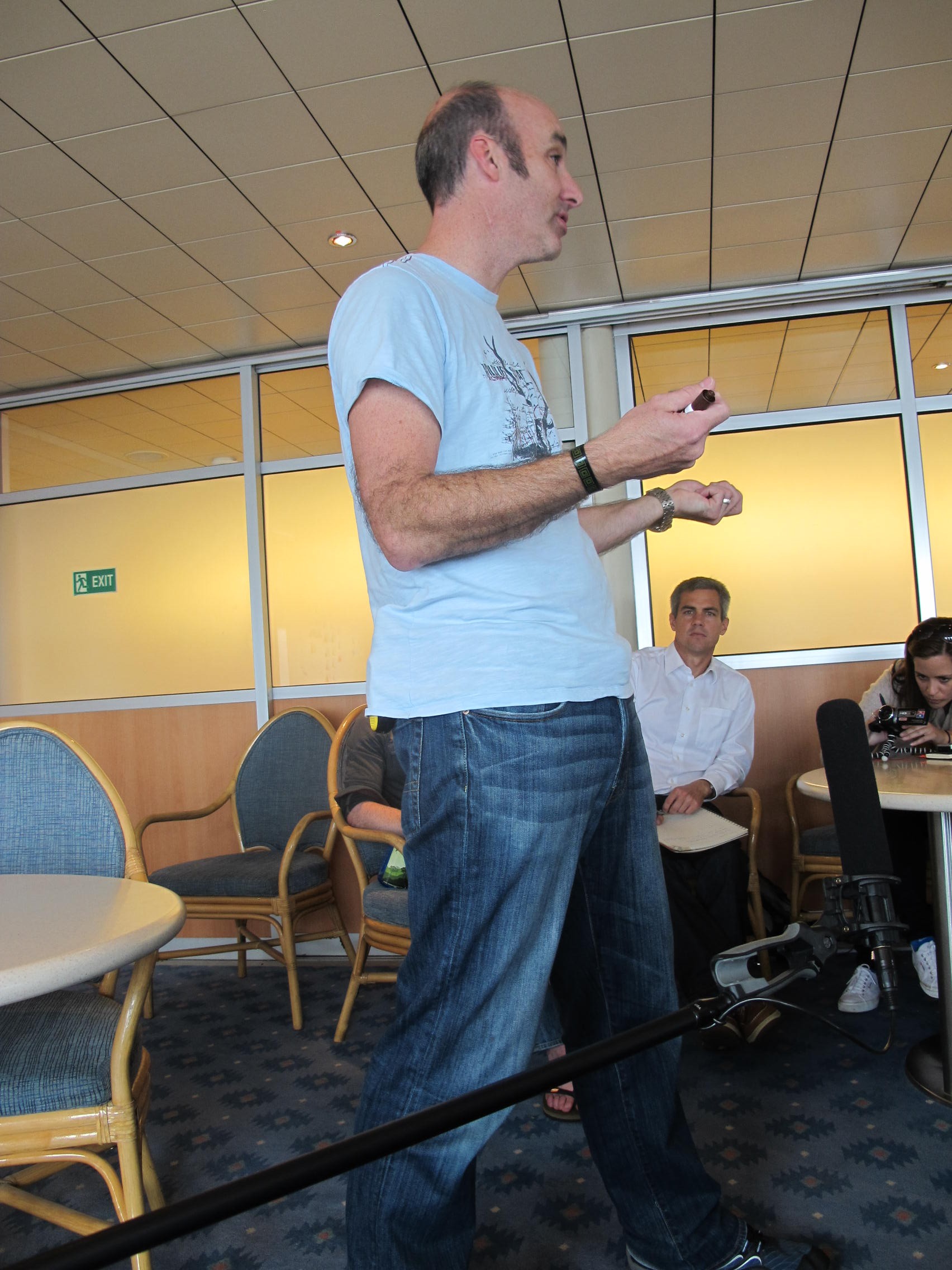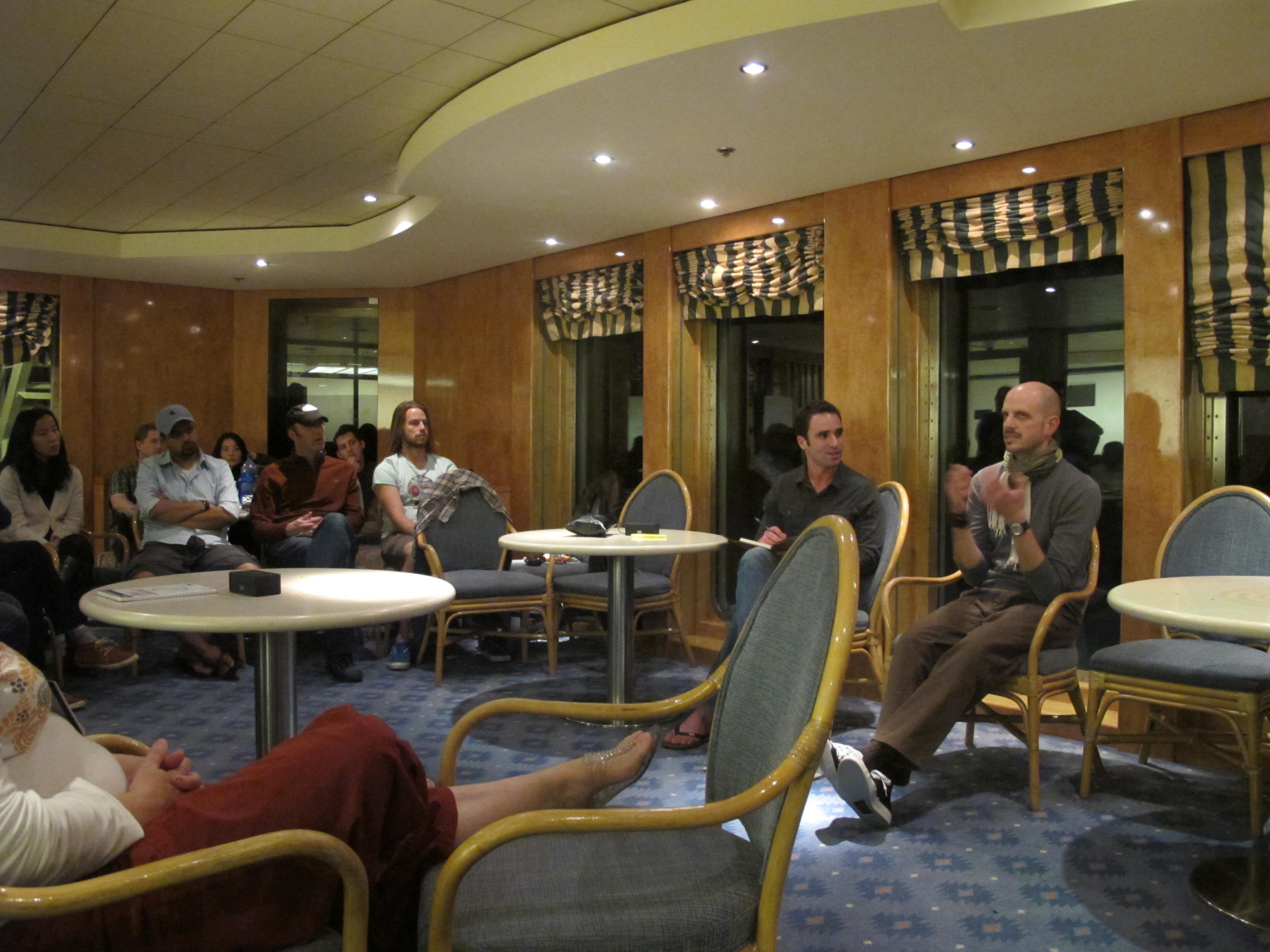Unreasonable at Sea day 4
I woke up and went running. The treadmill is crazy to run on when you are on a ship that is rocking constantly in all directions.

Morning: Workshop 1 with George Kembel, 10-12:30
1. expose what our company is all about
2 flipcams and documentation
–>George asks questions about the companies and we pay attention to what george is “after”
http://unreasonableatsea.com/prakti-design/
What is your company about? Who is it for? how many and what type of people? have you met people who cook with your stove, and without your stove?
why do they need your stove? save money. they buy it for reasons that are different than you think but why do you think they need it?
What was george after: understand the customer, relevant for its purpose, get the value proposition
-Highlight that he was after the human element
First he answered technically, but what does that mean to me?
Most people talks only about the solutions. Half the failures in industry are because you solved the wrong problem. But it’s Necessary to frame and understand the nature and need of the problem
But even for successful companies, sometimes the new market will be hard to fit into if we don’t constantly question redefine and learn if you have clarity on what it needed how you adore going to solve for it
In order to teach innovation & problem solving : solving is as important as the business and technology element, and state THAT independent of a solution
Elements that comprise Point of view:
User, need, insight
Who is this for? What do they need? Why do you have insight to solve for that
Eotional statement of the user: “she no longer smells like smoke”
Give the solution as an answer…it is a noun. A stove. That isn’t a solution. WHY does she need a better stove
Solution agnostic needs:there are different ways to solve this but if the first solution doesn’t work then how else cAn we meet ther needs?
Deeper you can get into what it means: “People don’t buy with their wallets but with their hearts”; Profound reason to engage with company
Empathy…have ideas that no one else has and can make someone’s life better: Varies with dif market and person
Then turned it from the human point of view to the market. Get someone to connect on an emotional level
Now, for Protei:
emotional language
–>USERS: (start with a story)people who have been struck by an environmental disaster i.e. fukushima, chad lake, ensenada red tides, residents of gulf of mexico. Fukushima residents wondering about the truth – should we leave or not, will we get cancer?; Tunisia / Italian immigrants – should we need surveillance from shore to see that we are dying?
proliferates much further than the coast line
–people are eating the fish from the water (oil spill, food, radioactivity contaminates the fish; widespread to many countries
–>NEED: Make ocean cleaning accessible to everyone – unite a non profit with a commercial group; these people need to be able to solve their own problems, and not wait for industry or government to do it for them;
–>INSIGHT: We are bridging between industry and the local people with the use of a new technology , build for maximum innovation; licensing, collaboration model (global decentralized research)
–many potential customers, start with the consumer because we are building from the ground up, in order to build for innovation and get a community to contribute to our technology
–user has a need, how your tech solves the problem
–what if the user doesn’t see our problem?
–tell someone: what do we do with oil? what do we do with trash?
latent need: how do you convince people that they actually need this, they cannot express themselves?
like the iPod, they did not know that this was out there but it is better
-you are not going to be told what you need to solve but by listening to them you have to make a leap. put something in the world, tell it in a story telling way. innovation: give someone something they never thought they’ve needed, then make them feel they can’t live without it
—> is the consumer who the story has to be about? i.e. we all want cheaper cars but don’t want to sacrifice safety
-but the consumer is actually going to be big industry, GM
-understand context and story at a much deeper level than the function they’re solving
advantage to come in and improve that – internal compass – question: do we know why we are doing what we are doing – draw from it to tell stories
Debrief – design thinking practice is very iterative, constnaly changing and redefining ourselves to be an adaptable organization because the world is changing fast;Adaptive and emergent
so open source : User development and low level innovation – the user and consumer also shares in the solution and defining their problem – is that what crowd and open source means?
there are many solutions, so a company needs to keep in mind that, and the problem that they are solving: brainstorm for the options then test for the best option
PART 2
flipcam
Cesar and I chat about our short term goals, long term goals, and how to organize the rest of the trip and each port’s goals; lots of notes on trello
-immediate needs: community website for research; commercial website for protei
–>protei’s applications are really broad, the destination will define the application (japan – radioactivity; hawaii = plastic trash)
-community : our clients and generate technology, buy products, use the license so they know the conditions for sharing ideas
-website: wikipedia but with proposed solutions: social media times wikipedia
“Fireside Chat” with Tom De Blasis, Global Design Director for Nike Soccer
-background, designer, global events, designing through one object to effect global change; brainstorming about ideas for helping out haiti – then figured out need to understand the user and understand the need
–what could possibly nike have to offer in a disaster
–as a designer, trained to connect things – look broadly and shallow, rather than deeply : situation with water… poor quality
–social entrepreneurship, design thinking : it’s the future, starting to coalesce

